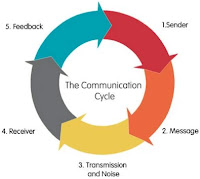Communication Cycle and Importance of Feedback | CBSE Class 10 IT (402)
The communication cycle consists of five elements as shown in the following diagram:
1. Sender: The sender is the individual who wishes to communicate a message.
2. Message: The message is the information the sender wishes the audience to receive and understand.
3. Transmission and noise (Channel): The transmission of the message is the actual process of sending it. This could be done via various verbal and written communication channels; for example email, letters, text, reports, face-to-face, telephone, and videoconferencing.
4. Receiver: The receiver tries to interpret the message by decoding the words and symbols used.
5. Feedback: The receiver feeds back their understanding of the message to the sender, to make sure that the message they received was the same message as the sender intended. This feedback can be a verbal or non-verbal response, for example saying yes or nodding the head.

Feedback
Feedback is an important part of the communication cycle. For effective communication, it is important that the sender receives an acknowledgement from the receiver about getting the message across. While a sender sends information, the receiver provides feedback on the received message. Translated to the work environment, when you observe someone perform their work and then, communicate with them to help improve their performances, you are giving feedback. Feedback can be positive or negative. Good feedback is always specific, helpful, and kind.
Feedback, if shared properly, can help reinforce existing strengths and can increase the recipient's abilities to rectify errors. It can have a long-term effect on managing and achieving goals.
Good feedback is one that is:
Specific: Avoid general comments. Try to include examples to clarify your statement. Offering' alternatives rather than just giving advice allow the receiver to decide what to do with your feedback.
Timely: Being prompt is the key since feedback loses its impact if delayed for too long.
Polite: While it is important to share feedback, the recipient should not feel offended by the language of the feedback.
Offering continuing support: Feedback sharing should be a continuous process. After offering feedback, let recipients know you are available for support.
Types of Feedback
1. Positive Feedback
Feedback about past behavior that produces the desired result or positively affects the desired outcome. Past successful behavior is praised here.
Example:
1. I noticed you finished work perfectly. Great job!
2. I really appreciate you taking that call. Can you please also share the details?
2. Negative Feedback
Feedback about past behavior that did not produce the desired results or worsened the situation. Here, the focus is on learning from past behavior and ensuring that it is correct in the future.
Example:
1. You keep forgetting to smile at the hotel guests when you talk to them.
2. You take really long to reply to e-mails! Are you always so busy?
3. No Feedback
It is also feedback in itself that indicates disagreement of ideas.
Importance of Feedback
Feedback is the final component and one of the most important factors in the process of communication since it is defined as the response given by the receiver to the sender. Let us look at certain reasons why feedback is important.
It validates effective listening: The person providing the feedback knows they have been understood (or received) and that their feedback provides some value.
It motivates: Feedback can motivate people to build better work relationships and continue the good work that is being appreciated.
It is always there: Every time you speak to a person, we communicate feedback so it is impossible not to provide one.
It boosts learning: Feedback is important to remain focussed on goals, plan better, and develop improved products and services.
It improves performance: Feedback can help to form better decisions to improve and increase performance.
